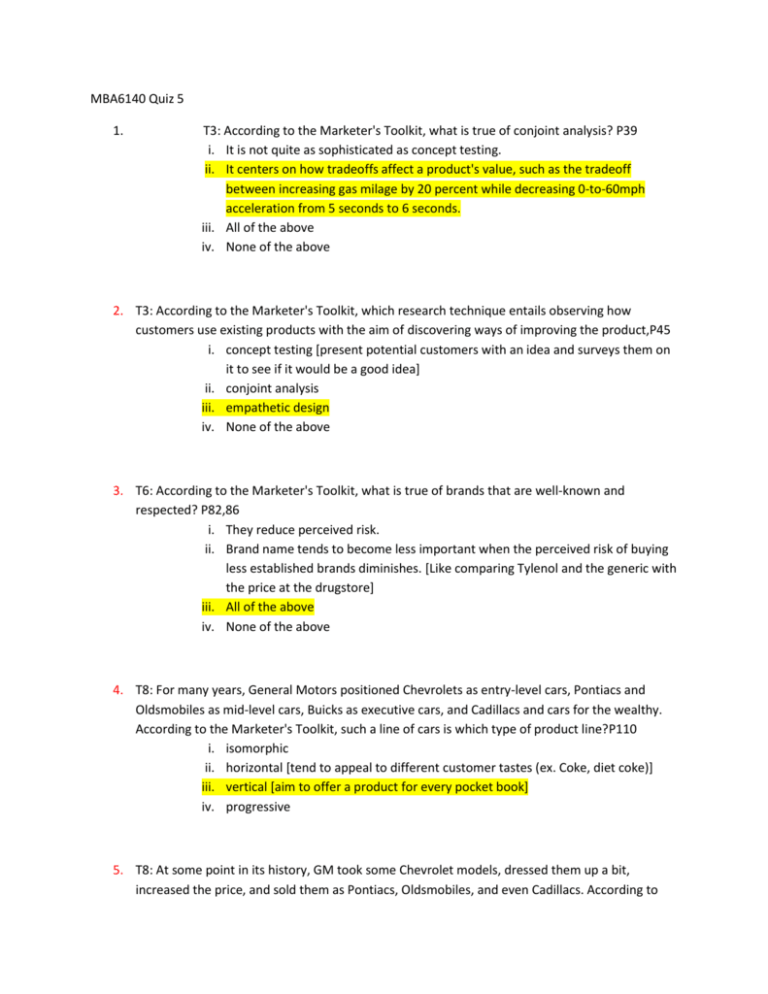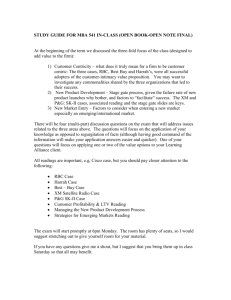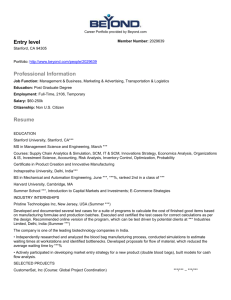MBA6140 Quiz 5
advertisement

MBA6140 Quiz 5 1. T3: According to the Marketer's Toolkit, what is true of conjoint analysis? P39 i. It is not quite as sophisticated as concept testing. ii. It centers on how tradeoffs affect a product's value, such as the tradeoff between increasing gas milage by 20 percent while decreasing 0-to-60mph acceleration from 5 seconds to 6 seconds. iii. All of the above iv. None of the above 2. T3: According to the Marketer's Toolkit, which research technique entails observing how customers use existing products with the aim of discovering ways of improving the product,P45 i. concept testing [present potential customers with an idea and surveys them on it to see if it would be a good idea] ii. conjoint analysis iii. empathetic design iv. None of the above 3. T6: According to the Marketer's Toolkit, what is true of brands that are well-known and respected? P82,86 i. They reduce perceived risk. ii. Brand name tends to become less important when the perceived risk of buying less established brands diminishes. [Like comparing Tylenol and the generic with the price at the drugstore] iii. All of the above iv. None of the above 4. T8: For many years, General Motors positioned Chevrolets as entry-level cars, Pontiacs and Oldsmobiles as mid-level cars, Buicks as executive cars, and Cadillacs and cars for the wealthy. According to the Marketer's Toolkit, such a line of cars is which type of product line?P110 i. isomorphic ii. horizontal [tend to appeal to different customer tastes (ex. Coke, diet coke)] iii. vertical [aim to offer a product for every pocket book] iv. progressive 5. T8: At some point in its history, GM took some Chevrolet models, dressed them up a bit, increased the price, and sold them as Pontiacs, Oldsmobiles, and even Cadillacs. According to the Marketer's Toolkit, such Chevrolets, Pontiacs, Oldsmobiles, and Cadillacs would be based on a common P110-111,123 i. marketing plan ii. product platform iii. blueprint iv. None of the above 6. T1(PLC): What is true of the product life cycle (PLC)?P11-12 i. Well-conceived market strategies generally are highly effective over all PLC stages because they are grounded in fundamental marketing principles and, therefore, need not be adapted to PLC changes. ii. Once the PLC is in motion, very little, if anything, can be done to alter its shape. iii. At the growth stage, most contestants usually focus their efforts on increasing the size of the market. [should be increasing shares of the growing pie not market, size of the market is for introduction phase] iv. All of the above v. None of the above 7. T1(PLC): Brand building is the main challenge at which PLC phase?P11 i. introduction ii. growth iii. maturity iv. decline 8. A5: According to "Diamonds in the Data Mine," what is true of Harrah's Las Vegas operations?P2 i. Like other hotel-casino operations, it relies on drawing customers with the latest "fantasyland" attractions. ii. Its core customers are out-of-towners who are particularly fond of poker. iii. Its key to success has been realizing that, to win at the casino "game," a company must outspend its rivals. iv. All of the above v. None of the above [Relies on casino revenue not all that other stuff, doesn’t outspend, there core customers are just slot players] 9. A5: According to "Diamonds in the Data Mine," what is true of the "Total Gold" program?P3 i. It was instituted by Harrah's to promote customer loyalty. ii. For many years, the program was highly differentiated from competing programs. [False, In truth it didn’t] iii. It greatly increased gambling revenues because it rewarded loyal patrons with free rooms and dinners. [False, In truth it didn’t] iv. All of the above v. None of the above 10. A5: According to "Diamonds in the Data Mine," what did Harrah's data mining discover?P3 i. Among Harrah's customers, no "heavy half" seemed to exist. ii. Although so-called high-rollers accounted for about 50 percent of Harrah's gambling revenues, high-rollers accounted for a disproportionately small share of revenues from restaurant and hotel services.[False, high rollers didn’t help much period] iii. Gambling revenues from locals was surprisingly low. [False,Were actually the highest] iv. None of the above 11. A5: According to "Diamonds in the Data Mine," what is true of Total Rewards, the successor to Total Gold?P4 i. It's a three-tier program. [Gold, Platinum, and Diamond] ii. It was intended to induce Gold card holders to become Diamond card holders by visibly demonstrating the benefits of being a Diamond card holder. iii. All of the above iv. None of the above 12. A5: According to "Diamonds in the Data Mine," what is true of Harrah's "data warehouse"?P3-4 i. It contained millions of transactional data points about customers (e.g., names, addresses, and various demographics), as well as details about their gambling spending and preferences. ii. It facilitated identifying and re-attracting customers who had spent $1,000 per month or more at Harrah's for quite some time, but had not visited Harrah's in three months. iii. It could tell management which customers were playing at particular slots in Harrah's Las Vegas and what it was about that specific machine that appealed to them. iv. All of the above v. None of the above 13. A6: According to the article "Spend a Day in the Life of Your Customers," what is the single most important skill a senior executive can use to make strategic decisions?P1 i. The ability to ask the right questions. ii. The ability to direct the marketing research staff. iii. The ability to empathize with and gain insights from customers iv. The ability to detect changing trends v. The ability to get the most out of the marketing department 14. A6: What is true of industrial companies?P2 i. Most define the customer as the nearest (downstream) link in the distribution channel (e.g., a wholesaler) ii. They should try to understand all links in the distribution chain, including the end user iii. All of the above iv. None of the above 15. A6: The tendency of competing products (e.g., different brands of PCs) to become increasingly similar over the course of time is called P3 i. similarization ii. desegmentation iii. disintermediation iv. commoditization v. convolution 16. A6: Recall the tale of Woodbridge Papers, which is recounted in the article "Spend a Day in the Life of Your Customers."P3 i. The marketing manager charged that sales declines were due to manufacturing's refusal to expand product lines to better meet diverse customer requirements. ii. Manufacturing claimed the company's order-to-delivery cycle would be shorter if the company didn't offer so many different types of paper. iii. All of the above iv. Woodbridge's order-to-delivery cycle was long and slow, even though Woodbridge kept product variety to a minimum by focusing only on items with high inventory turns. 17. A6: At Woodbridge, activity-based costing showed that about 35%, or 150, items were destroying about 40% of the company's profits. According to the tale,P4 i. Woodbridge eliminated most or all of the profit-destroying products. ii. Surprisingly, eliminating unprofitable products did not improve the order-todelivery cycle. iii. All of the above iv. None of the above 18. A6: According to the Woodbridge tale's hypothetical first ending, what happened about a year after Woodbridge responded to the activity-based costing analysis?P4 i. Competition intensified, and profit margins declined sharply ii. Woodbridge had matched the order-to-delivery cycles of its nearest competitors iii. Woodbridge enjoyed neither a diversification nor a cost advantage iv. All of the above 19. A6: The authors of the Woodbridge tale concocted an alternate "real" ending based on the actions of an actual company. According to the alternate ending,P4-5, 7 i. Woodbridge met with a soup manufacturer and a printer (who printed labels for the soup manufacturer) to learn about the intricacies of the soup businesses and how printing labels and Woodbridge paper fit into the scheme of things ii. Woodbridge redesigned its manufacturing system around core customers' requirements iii. All of the above iv. None of the above 20. A6: The article "Spend a Day in the Life of Your Customers" contained an insert about Wireline. What does that insert illustrate?P6 i. Just-in-time (JIT) inventory management can the a win-win system for both the buyer and the supplier. ii. Disintermediation should not be undertaken without carefully evaluating its impact on the value chain. iii. Matching offerings and prices to customers' requirements is very important. iv. The old maxim about "Let the buyer beware," or caveat emptor, is still true today. v. None of the above 21. A7: In the article "Staple Yourself to an Order," OMC stands for P1 i. operations management chart ii. order management cycle [the ten steps, from planning to postsales service, that define a company's business system.] i. operations management control ii. outside marketing company 22. A7: According to"Staple Yourself to an Order," what is the source of a common problem in business?P3 i. Most business organizations are too hierarchical; they need to be flattened. ii. Companies usually are organized along vertical functional lines, but orders move horizontally across functions. Thus, something along the way often falls between the cracksas orders move through the organization. iii. Top management spends too much time chasing down customer complaints because it does not empower lower organizations to solve problems. iv. All of the above v. None of the above 23. A7: According to"Staple Yourself to an Order," what should pricing orders reflect?P3 i. the customer value generated by each order; i.e., the value of each order to the customer ii. the cost of filling each order iii. All of the above iv. None of the above [Pricing at the individual order level depends on understanding the customer value generated by each order, evaluating the cost of filling each order, and instituting a system that enables the company to price each order based on its value and cost.] 24. A7: According to"Staple Yourself to an Order," what is a common source of order processing problems?P3-4 i. fighting among functional areas or departments ii. conflicting incentives and, hence, conflicting objectives among functional areas or departments iii. All of the above iv. None of the above; surprisingly, fighting and conflicts among departments is a rarity in the vast majority of companies 25. A7: According to "Staple Yourself to an Order," what actions did two organizations take to try to alleviate OMC problems?P6 i. One went to a JIT system, and the other fired unprofitable customers. ii. One used a CAD system to speed up design and manufacturing; the other used RFD to track orders more precisely. iii. One prioritized orders based on profitability; the other ran three shifts seven days per week. iv. One increased work-in-process inventory so that orders would not have to be started from scratch; the other invested in expanding its facilities. Neither effort was successful. 26. A7: Regarding According to "Staple Yourself to an Order," the critical problems that both of the noted organizations had included P7 i. horizontal and vertical OMC gaps ii. poor order prioritization iii. inaccurate cost estimation iv. All of the above 27. A7: According to "Staple Yourself to an Order," most effective efforts to improve the OMC include P8 i. focusing on understanding systems, including compenation and other incentive systems ii. political strategy iii. All of the above iv. None of the above [Analysis, system focus (compensation), and political strategy] 28. A7: According to "Staple Yourself to an Order," what is most helpful when trying to work across departments?P9 i. excellent analytical skills ii. the ability to communicate effectively, especially in writing iii. understanding company politics iv. customer-centered strategic vision 29. N6: What does "Marketing Malpractice" suggest?P1 i. Surprisingly, demographic segmentation is more effective than life-style segmentation. ii. To develop a successful product, a marketer usually must understand what the customer wants done and whether the product can help the customer do the job effectively. iii. When designing new products, marketers generally are well-advised to focus on functional characteristics much more than social and emotional aspects. iv. All of the above 30. N6: Why did the Quicken Financial Planner fail?P1 i. It had a bug that sometimes gave users bad advice. ii. Ineffective promotion resulted in a small market share. iii. Quicken did not realize that the price was too high until it was too late to save the product. iv. The product performed a job that few people wanted to perform themselves, not even with assistance from reputable software. 31. N6: What is the "flaw of averages," and how does it pertain to brand management?P1 i. Averages give managers the impression that things are better than they really are; thus, average measures of brand equity tend to overrate equity. ii. Averages imply homogeneity and obscure heterogeneity; thus, measures of brand strength give the false impression that a brand is perceived similarly by all customers. iii. Averages include the mean, the median, and the mean; thus, when measuring brand equity, it's important to note which of the three averages was used. iv. The "flaw of averages" occurs when calculations aren't weighted in accordance with segment size when calculating the likes of brand strength or brand equity. 32. N6: According to "Marketing Malpractice,"P2 i. Sony was a leader in early demographic segmentation research. ii. Sony founder Akio Morita developed market segmentation and targeting via statistical clustering of customers. iii. To get ideas for new products, Sony observed what people were trying to get done and then tried to develop products that would help them get such jobs done. iv. All of the above 33. N6: According to "Marketing Malpractice,"P2 i. Advertising was the key to building most great brands. ii. Understanding how advertising influences consumer decision making is the key to developing successful new products. [it’s not a substitute for product design] iii. All of the above iv. None of the above. 34. N6: Advertising is the key to building P2 i. endorser brands ii. aspirational purpose brands iii. brand extension iv. All of the above 35. N7: The authors of "Corporate Imagination and Expeditionary Marketing" cautioned against what?P1 i. disintermediation ii. investing too little in scientific customer survey research iii. massmarketing iv. outsourcing core competencies v. NAFTA 36. N7: The authors of "Corporate Imagination and Expeditionary Marketing" suggested that P1 i. executives must have the imagination to envision markets that do not yet exist and stake them out ahead of competitors ii. executives should let sound customer survey research guide their decisions; moreover, they should resist the urge to act instinctively iii. typical executives spend too little time exploring potential strategic alliances iv. the ability to think creatively is lost if it is not exercised regularly 37. N7: The authors of "Corporate Imagination and Expeditionary Marketing" suggested that P1 i. executives should consider the likely impact of undertaking a new opportunity on current businesses ii. executives must look beyond the likely impact of undertaking a new opportunity on current businesses iii. All of the above iv. None of the above 38. N7: According to "Corporate Imagination and Expeditionary Marketing," what is true of Xerox's copier strategy in the 1970s?P1 i. Xerox's strategy was so effective that, in the 1970s, Xerox was the market-share and profit leader in both the large and the small copier segments. ii. When small copiers appeared, Xerox quickly diverted resources from large to small copiers and, but was unable to maintained its market share. iii. Because small copiers would cannibalize large copier profits, Xerox focused on protecting its core business, which was large copiers. iv. Xerox developed an electrostatic copying process that enabled it to surpass Canon in small copiers. v. Xerox relied on its corporate clout to control the copier market. 39. N7: The authors of "Corporate Imagination and Expeditionary Marketing" advise firms to escape "the tyranny of served markets" by doing what?P1 i. Envisioning the firm as a portfolio of core competencies rather than as a portfolio of products. ii. Envision the firm as a portfolio of customers rather than as a portfolio of businesses. iii. Imagining what unserved markets need, want, and prefer. iv. Investing heavily in research and development (R&D) of technologies that are unrelated to current competencies. v. None of the above [Searching for innovative product concepts; overturning traditional assumptions about price/performance relationships; and leading customers rather than simply following them.] 40. N7: According to "Corporate Imagination and Expeditionary Marketing," firms that ask customers what they want and respond strictly to what customers tell them P2 i. tend to be market-share leaders because they adhere closely to the marketing concept. ii. end up as perpetual followers rather than market leaders. iii. minimize risk, which translates into higher share prices. iv. tend to be research and development (R&D) leaders 41. N7: The authors of "Corporate Imagination and Expeditionary Marketing" warned that P3 i. before developing new products, most companies should conduct much more survey research to assess what the targeted market really wants. ii. marketers are not making optimum use of perceptual mapping when developing new products. iii. marketers are not making optimum use of conjoint analysis when developing new products. iv. marketing research that attempts to assess demand for new products that are not yet available is notoriously inaccurate. 42. N7: With regard to new products, the authors of "Corporate Imagination and Expeditionary Marketing" maintain that P3 i. it is very hard to obtain reliable and useful information about customer acceptance and preferences until some form of the new product is launched. ii. success usually does not depend as much on launching a form of the product that closely matches customer preferences as on learning from customers after the product is launched and modifying the product accordingly. iii. All of the above iv. None of the above 43. N7: What is true of expeditionary marketing?P3 i. It immediately increases the new-product success rate (i.e., the ratio of success in relation to failures) because it weeds out products that have little chance of succeeding before they are actually launched ii. It increases the number successes by launching more new products or variants of new products iii. All of the above iv. None of the above 44. N7: According to "Corporate Imagination and Expeditionary Marketing," what do most companies do when new products fail?P4 i. Find someone to blame ii. Try to understand why the product failed so that mistakes aren't repeated iii. Cut research and development (R&D) budgets iv. Increase research and development (R&D) budgets 45. N8: The main themes of "A Different Approach for Developing New Products" include:P1-2 i. Asking customers what they want in a product is less productive and illuminating than asking them about problems they are having with the focal product. [They should focus on solving problems then develop the product] ii. Conducting market surveys that ask respondents to rate the importance of various product attributes is the most effective way of gaining insights into new products that will sell.[you shouldn’t do this] iii. All of the above iv. None of the above






